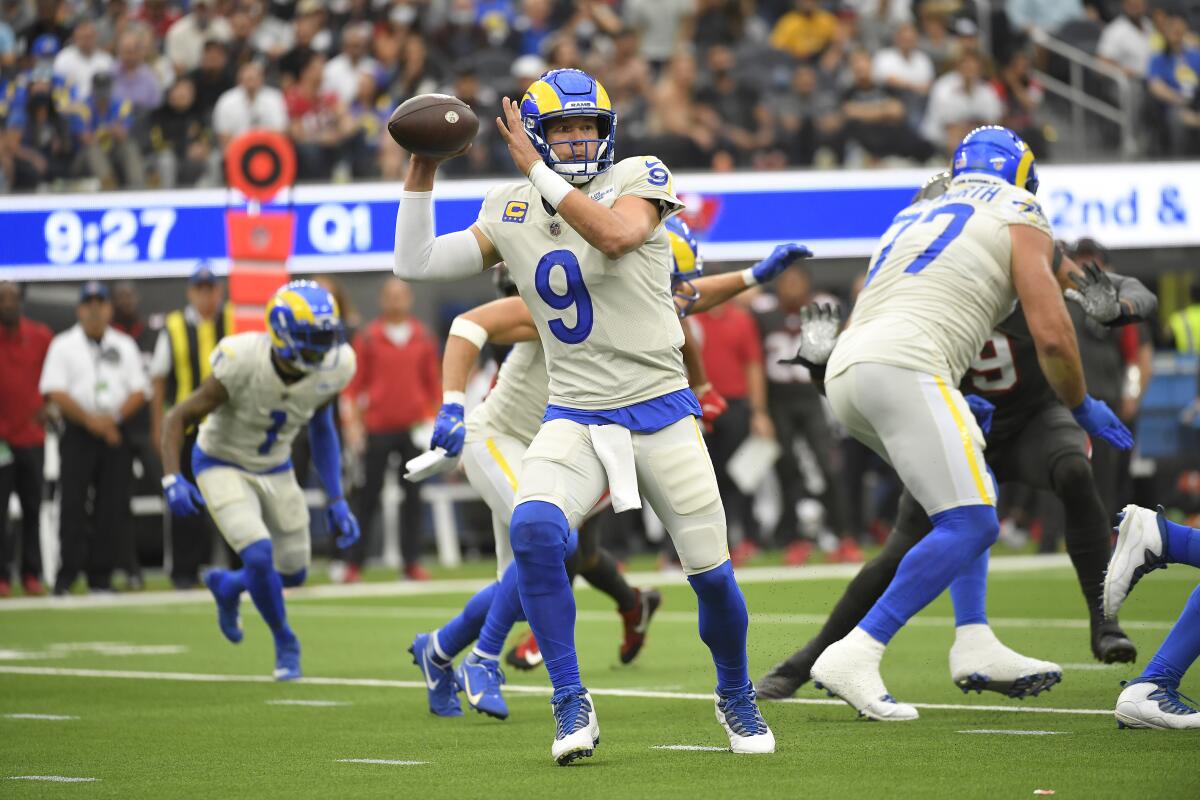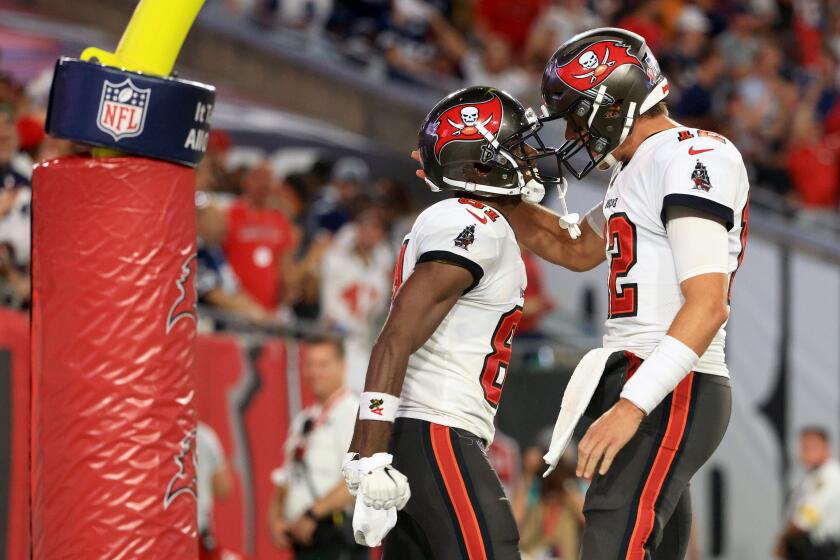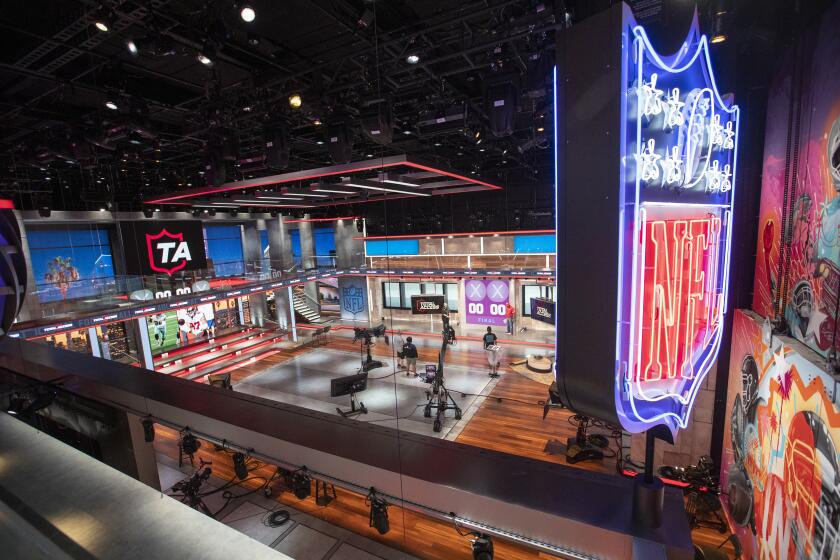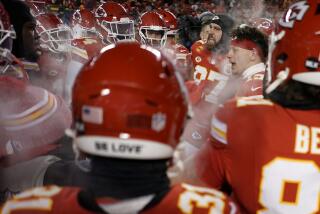Why NFL TV ratings are rebounding this season

- Share via
The National Football League is defying gravity in the changing television universe.
Three weeks into the 2021 season, overall viewing of the NFL is up 9% over the comparable period last year according to data from Nielsen and the league’s partners, with an average of 16.9 million viewers on TV and digital platforms. It’s the best start for the league since 2016, which analysts attribute in part to the easing of the pandemic and other factors.
CBS’ Sunday games are averaging 17.1 million viewers, up 16% over last year. NBC’s “Sunday Night Football” is up 12% to 21.8 million viewers in the U.S. ESPN’s “Monday Night Football” is pulling in 14.7 million viewers, a 17% gain. Only Fox has seen a decline — down 13% to 16.2 million viewers — largely due to a blowout loss for the Green Bay Packers in its first national telecast.
The ratings rise is occurring as the overall usage of TV declined by 9% over the same period. Nearly all other dependable television franchises have seen their audiences erode in the face of viewer migration to streaming video platforms.
The top prime-time entertainment program last week was CBS’ “NCIS,” which scored 8.4 million viewers — about half of what the drama scored during premiere week five years ago.
Every major TV awards show hit an all-time ratings low over the last year, a streak that ended when the 73rd Emmy Awards show saw its viewership rebound on Sept. 20. But even that event got a boost from an NFL game lead-in on CBS.
The Tampa Bay Buccaneers’ nail-biting win over the Dallas Cowboys scores big for the league and NBC.
The NFL’s start is its strongest since 2016, the year the league faced criticism from then-presidential candidate Donald Trump over players kneeling during the national anthem to protest police violence against the Black community. Cable news ratings also surged once Trump became president and his administration became a must-watch saga for viewers.
Brian Rolapp, chief media and business officer for the NFL, said the league never saw any evidence that political divisiveness in the country cut into its TV audience. But he acknowledged the league is benefitting from the shift away from cable news, where viewing reached record levels last year.
“We never really saw a ton of evidence that our viewership was materially impacted when we were more in the political news,” Rolapp said. “I think it’s a return to lighter things to watch. There has been a lot of heavy news and topics for people to consume on television in the past couple of years. They are migrating to things that are much more unifying and football is one of those things.”
According to the NFL’s analysis of Nielsen data, total viewing of cable news in the hours when football is on is down around 30% from a year ago.
TV news siphoning NFL viewers is not a Trump-era phenomenon, Rolapp said, noting that NFL ratings declined in every presidential election year since 1996.
The easing of the pandemic is also bringing viewers back after last season, when the league saw its regular season TV ratings drop 7%. Teams were playing in the bleak atmosphere of empty stadiums for most of the year and COVID-19 protocols led to unexpected shifts in the schedule.
The move to Inglewood from Culver City comes after NFL Media struggled for years with outdated technology.
“I think it’s hard to overstate the importance of the return of fans and the raucous environment that contributes so much to the experience,” said Mike Mulvihill, executive vice president and head of strategy and analytics for Fox Sports.
The NFL is also not facing the unusual competition it saw in 2020 from the shakeup in the sports calendar, as the pandemic pushed the NBA playoffs, the Stanley Cup playoffs and the Masters golf tournament into the fall.
While Fox saw a lopsided game in its first week, the league’s other networks have benefitted from five nationally televised contests that were decided on the last play.
“That’s something you can’t really plan for, but there’s no doubt it’s been a significant contributor,” Mulvihill said.
Mulvihill is optimistic about the potential ratings performance for the Fox schedule, with its two most popular National Football Conference teams, the Packers and the Dallas Cowboys, appearing on the network 20 times over the rest of the season.
“All our biggest games are still ahead of us,” Mulvihill said.
The league’s research saw pent-up demand among fans for football’s return before the season began. The NFL Network posted record ratings for this year’s preseason games, after seeing exhibition contests canceled last year due to the pandemic.
Going forward, the league will also see the impact of legalized sports betting, which is now legal in 25 states and Washington, D.C., up from 18 a year ago.
The typically cautious NFL has embraced the trend. Earlier this year, Caesars Entertainment, DraftKings and FanDuel became “official sports betting partners” of the league, a designation allowing the companies to use the NFL’s logo in any marketing or advertising it does around league events or during telecasts of its games.
The league still limits the amount of sports betting advertising on its telecasts and polices the copy contained in commercials.
Rolapp expects wagering viewers to stay tuned into games longer and increase the number of games they watch, especially later in the season for contests that don’t have playoff implications.
“I think over time it may not draw in new fans but it may increase the engagement of the fans we already have,” Rolapp said.
The league is also encouraged by the enhancements to the NFL broadcasts. ESPN has generated significant buzz for its “Monday Night Football” franchise with a simulcast on ESPN 2 featuring commentary by brothers Eli and Peyton Manning, where the retired quarterbacks combine their granular knowledge of the on-field action with playful fraternal hazing.
The audience for the Mannings grew from 800,000 in the first week to 1.9 million this past Monday for the Dallas Cowboys’ 41-21 win over the Philadelphia Eagles, boosting the total viewership for “Monday Night Football.”
Rolapp points to the “Manning cast” as part of the league’s effort to reach younger fans who want an alternative to a straight-ahead approach in the broadcast booth. The league is increasing the number of kid-oriented game presentations on ViacomCBS’ Nickelodeon, which won raves earlier this year for its coverage of a wild card playoff game.
“You’re going to see us doing more of those sorts of things,” Rolapp said.
The NFL’s ratings resilience in the face of a far more competitive environment for viewers’ attention helps explain the nearly 100% increase the league received in its new 11-year media rights deal which takes effect in 2022 and 2023, lifting its annual take to $9 billion a year.
More to Read
Inside the business of entertainment
The Wide Shot brings you news, analysis and insights on everything from streaming wars to production — and what it all means for the future.
You may occasionally receive promotional content from the Los Angeles Times.













